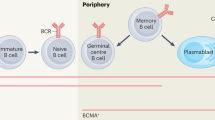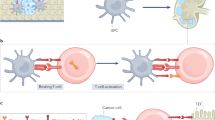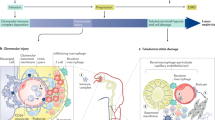Key Points
-
Disease classifications that define syndromes by their pathogenesis rather than their histopathological appearance or biomarker profile increase the likelihood of identifying effective treatments that will succeed in clinical trials
-
Patients need to be better stratified according to the likelihood that they will respond to certain drugs by combining the concepts of evidence-based and personalized medicine
-
Most immune-mediated kidney diseases are rare, implying that national registries and clinical trial networks will be needed to progress translational research and clinical trials
-
To improve the applicability of findings from preclinical animal studies to human disease not only are better disease models needed, but study designs must more closely reflect those of clinical trials
-
Testing of novel drugs in an add-on design should not be considered unless supported by respective preclinical studies; add-on designs are less suitable for drugs with similar modes-of-action
-
Biomarkers of intrarenal inflammation, nephron injury, and nephron number need to be identified and established as surrogate markers of disease activity and nephron loss
Abstract
Innovative immunotherapies continue to markedly benefit many disciplines in clinical medicine but disappointingly, these benefits have not translated to the treatment of kidney diseases despite encouraging findings from preclinical models of kidney dysfunction. This lack of progress in nephrology might relate to the unique biology of the kidney. More likely, this lack of progress relates to conceptual hurdles in the application of newer therapies to renal disease. In this Review we discuss seven hurdles that must be addressed in order to appropriately assess and introduce immunologic therapies for immune-mediated kidney disease: the use of appropriate criteria to define disease categories; issues relating to the heterogeneity of kidney diseases and how this heterogeneity affects approaches to treatment; issues related to the rarity of most kidney diseases; the paucity of good animal models of human kidney disease; issues relating to trial design; problems with current approaches to the identification and use of appropriate and feasible study end points; and a lack of adequate biomarkers of intrarenal inflammation and parenchymal injury. We suggest that overcoming these hurdles, in addition to searching for better therapeutic targets, will be necessary to progress the treatment of immune-mediated kidney disease into a new age of drug therapy.
This is a preview of subscription content, access via your institution
Access options
Subscribe to this journal
Receive 12 print issues and online access
$209.00 per year
only $17.42 per issue
Buy this article
- Purchase on Springer Link
- Instant access to full article PDF
Prices may be subject to local taxes which are calculated during checkout


Similar content being viewed by others
References
Machowska, A. et al. Therapeutics targeting persistent inflammation in chronic kidney disease. Transl. Res. 167, 204–213 (2015).
Weening, J. J. & Jennette, J. C. Historical milestones in renal pathology. Virchows Arch. 461, 3–11 (2012).
Trachtman, H. et al. A phase 1, single-dose study of fresolimumab, an anti-TGF-β antibody, in treatment-resistant primary focal segmental glomerulosclerosis. Kidney Int. 79, 1236–1243 (2011).
Giglio, S. et al. Heterogeneous genetic alterations in sporadic nephrotic syndrome associate with resistance to immunosuppression. J. Am. Soc. Nephrol. 26, 230–236 (2015).
Sadowski, C. E. et al. A single-gene cause in 29.5% of cases of steroid-resistant nephrotic syndrome. J. Am. Soc. Nephrol. 26, 1279–1289 (2015).
Freedman, B. I. et al. End-stage renal disease in African Americans with lupus nephritis is associated with APOL1. Arthritis Rheumatol. 66, 390–396 (2014).
Larsen, C. P. et al. Apolipoprotein L1 risk variants associate with systemic lupus erythematosus-associated collapsing glomerulopathy. J. Am. Soc. Nephrol. 24, 722–725 (2013).
Kottgen, A. et al. Multiple loci associated with indices of renal function and chronic kidney disease. Nat. Genet. 41, 712–717 (2009).
Soleymanian, T. et al. Non-diabetic renal disease with or without diabetic nephropathy in type 2 diabetes: clinical predictors and outcome. Ren. Fail. 37, 572–575 (2015).
Hildebrandt, F. Genetic kidney diseases. Lancet 375, 1287–1295 (2010).
Roche, P. A. & Furuta, K. The ins and outs of MHC class II-mediated antigen processing and presentation. Nat. Rev. Immunol. 15, 203–216 (2015).
Kidney Disease: Improving Global Outcomes (KDIGO) Transplant Work Group. KDIGO 2012 clinical practice guideline for the evaluation and management of chronic kidney disease. Kidney Int. Suppl. 3, 1–150 (2013).
Kidney Disease: Improving Global Outcomes (KDIGO) Transplant Work Group. KDIGO clinical practice guideline for the care of kidney transplant recipients. Am. J. Transplant. 9 (Suppl. 3), S1–S155 (2009).
Weening, J. J. et al. The classification of glomerulonephritis in systemic lupus erythematosus revisited. J. Am. Soc. Nephrol. 15, 241–250 (2004).
Boneparth, A. & Ilowite, N. T. Comparison of renal response parameters for juvenile membranous plus proliferative lupus nephritis versus isolated proliferative lupus nephritis: a cross-sectional analysis of the CARRA Registry. Lupus 23, 898–904 (2014).
Radhakrishnan, J. et al. Mycophenolate mofetil and intravenous cyclophosphamide are similar as induction therapy for class V lupus nephritis. Kidney Int. 77, 152–160 (2010).
Miyake, K., Akahoshi, M. & Nakashima, H. Th subset balance in lupus nephritis. J. Biomed. Biotechnol. 2011, 980286 (2011).
Rezende, G. M. et al. Podocyte injury in pure membranous and proliferative lupus nephritis: distinct underlying mechanisms of proteinuria? Lupus 23, 255–262 (2014).
Mysler, E. F. et al. Efficacy and safety of ocrelizumab in active proliferative lupus nephritis: results from a randomized, double-blind, phase III study. Arthritis Rheum. 65, 2368–2379 (2013).
Cattran, D. C. et al. The Oxford classification of IgA nephropathy: rationale, clinicopathological correlations, and classification. Kidney Int. 76, 534–545 (2009).
Grootscholten, C. et al. Interobserver agreement of scoring of histopathological characteristics and classification of lupus nephritis. Nephrol. Dial. Transplant. 23, 223–230 (2008).
Rovin, B. H., Parikh, S. V. & Alvarado, A. in Systemic Lupus Erythematosus (eds Ginzler, E. M. & Dooley, M. A.) 537–552 (Elsevier, 2014).
Wilhelmus, S. et al. Interobserver agreement on histopathological lesions in class III or IV lupus nephritis. Clin. J. Am. Soc. Nephrol. 10, 47–53 (2014).
Peterson, K. S. et al. Characterization of heterogeneity in the molecular pathogenesis of lupus nephritis from transcriptional profiles of laser-captured glomeruli. J. Clin. Invest. 113, 1722–1733 (2004).
Parikh, S. et al. Characterizing the immune profile of the kidney biopsy at lupus nephritis flare differentiates early treatment responders from non-responders. Lupus Sci. Med. 2, e000112 (2015).
Parikh, S. V., Ayoub, I. & Rovin, B. H. The kidney biopsy in lupus nephritis: time to move beyond histology. Nephrol. Dial. Transplant. 30, 3–6 (2015).
Rovin, B. H. et al. Efficacy and safety of rituximab in patients with active proliferative lupus nephritis: the lupus nephritis assessment with rituximab study. Arthritis Rheum. 64, 1215–1226 (2012).
McGrogan, A., Franssen, C. F. & de Vries, C. S. The incidence of primary glomerulonephritis worldwide: a systematic review of the literature. Nephrol. Dial. Transplant. 26, 414–430 (2011).
Stone, J. H. et al. Rituximab versus cyclophosphamide for ANCA-associated vasculitis. N. Engl. J. Med. 363, 221–232 (2010).
Ruggenenti, P. et al. Anti-phospholipase A2 receptor antibody titer predicts post-rituximab outcome of membranous nephropathy. J. Am. Soc. Nephrol. 26, 2545–2558 (2015).
López-Gómez, J. M. & Rivera, F. Renal biopsy findings in acute renal failure in the cohort of patients in the Spanish Registry of Glomerulonephritis. Clin. J. Am. Soc. Nephrol. 3, 674–681 (2008).
Gadegbeku, C. A. et al. Design of the Nephrotic Syndrome Study Network (NEPTUNE) to evaluate primary glomerular nephropathy by a multidisciplinary approach. Kidney Int. 83, 749–756 (2013).
Coppo, R. et al. VALIGA study of the ERA-EDTA Immunonephrology Working Group. Kidney Int. 86, 828–836 (2014).
Jayne, D. & Rasmussen, N. Twenty-five years of European Union collaboration in ANCA-associated vasculitis research. Nephrol. Dial. Transplant. 30 (Suppl. 1), i1–i7 (2015).
Morrish, A. T. et al. Establishing a clinical trials network in nephrology: experience of the Australasian Kidney Trials Network. Kidney Int. 85, 23–30 (2014).
Walsh, M. et al. Plasma exchange and glucocorticoid dosing in the treatment of anti-neutrophil cytoplasm antibody associated vasculitis (PEXIVAS): protocol for a randomized controlled trial. Trials 14, 73 (2013).
Howman, A. et al. Immunosuppression for progressive membranous nephropathy: a UK randomised controlled trial. Lancet 381, 744–751 (2013).
Fervenza, F. C. et al. A multicenter randomized controlled trial of rituximab versus cyclosporine in the treatment of idiopathic membranous nephropathy (MENTOR). Nephron 130, 159–168 (2015).
Dooley, M. A. et al. Mycophenolate versus azathioprine as maintenance therapy for lupus nephritis. N. Engl. J. Med. 365, 1886–1895 (2011).
de Zeeuw, D. et al. The effect of CCR2 inhibitor CCX140-B on residual albuminuria in patients with type 2 diabetes and nephropathy: a randomised trial. Lancet Diabetes Endocrinol. 3, 687–696 (2015).
US National Library of Medicine. ClinicalTrials.gov [online], (2015).
US National Library of Medicine. ClinicalTrials.gov [online], (2014).
US National Library of Medicine. ClinicalTrials.gov [online], (2015).
Boumpas, D. T. et al. A short course of BG9588 (anti-CD40 ligand antibody) improves serologic activity and decreases hematuria in patients with proliferative lupus glomerulonephritis. Arthritis Rheum. 48, 719–727 (2003).
Appel, G. B. et al. Mycophenolate mofetil versus cyclophosphamide for induction treatment of lupus nephritis. J. Am. Soc. Nephrol. 20, 1103–1112 (2009).
Holderied, A. & Anders, H. J. Animal models of kidney inflammation in translational medicine. Drug Discov. Today Dis. Models 11, 19–27 (2014).
Hirst, J. A. et al. The need for randomization in animal trials: an overview of systematic reviews. PLoS ONE 9, e98856 (2014).
Llovera, G. et al. Results of a preclinical randomized controlled multicenter trial (pRCT): anti-CD49d treatment for acute brain ischemia. Sci. Transl. Med. 7, 299ra121 (2015).
Group, A. T. Treatment of lupus nephritis with abatacept: the abatacept and cyclophosphamide combination efficacy and safety study. Arthritis Rheumatol. 66, 3096–3104 (2014).
Condon, M. B. et al. Prospective observational single-centre cohort study to evaluate the effectiveness of treating lupus nephritis with rituximab and mycophenolate mofetil but no oral steroids. Ann. Rheum. Dis. 72, 1280–1286 (2013).
D'Acquisto, F. M., May, J. & Ghosh, S. Inhibition of nuclear factor kappa B (NF-B): an emerging theme in anti-inflammatory therapies. Mol. Interv. 2, 22–35 (2002).
Lourenco, E. V. et al. Laquinimod delays and suppresses nephritis in lupus-prone mice and affects both myeloid and lymphoid immune cells. Arthritis Rheumatol. 66, 674–685 (2014).
Jayne, D. et al. The pharmacokinetics of laquinimod and mycophenolate mofetil during treatment of active lupus nephritis. Presented at the American Society of Nephrology Annual Meeting, Atlanta (2013).
Enia, G. et al. Complement activated leucopenia during hemodialysis: effect of pulse methyl-prednisolone. Int. J. Artif. Organs 13, 98–102 (1990).
Jansen, N. J. et al. The role of different types of corticosteroids on the inflammatory mediators in cardiopulmonary bypass. Eur. J. Cardiothorac. Surg. 5, 211–217 (1991).
Malvar, A. et al. Histologic versus clinical remission in proliferative lupus nephritis. Nephrol. Dial. Transplant. http://dx.doi.org/10.1093/ndt/gfv296 (2015).
Dall'era, M. et al. Identification of biomarkers that predict response to treatment of lupus nephritis with mycophenolate mofetil or pulse cyclophosphamide. Arthritis Care Res. (Hoboken) 63, 351–357 (2011).
Dall'Era, M. et al. Predictors of long-term renal outcome in Lupus Nephritis Trials: lessons learned from the Euro-Lupus Nephritis Cohort. Arthritis Rheumatol. 67, 1305–1313 (2015).
Tamirou, F. et al. Long-term follow-up of the MAINTAIN Nephritis Trial, comparing azathioprine and mycophenolate mofetil as maintenance therapy of lupus nephritis. Ann. Rheum. Dis. http://dx.doi.org/10.1136/annrheumdis-2014-206897 (2015).
Beck, L. H. Jr et al. Rituximab-induced depletion of anti-PLA2R autoantibodies predicts response in membranous nephropathy. J. Am. Soc. Nephrol. 22, 1543–1550 (2011).
Reich, H. N. et al. Remission of proteinuria improves prognosis in IgA nephropathy. J. Am. Soc. Nephrol. 18, 3177–3183 (2007).
Sharma, A., Mucino, M. J. & Ronco, C. Renal functional reserve and renal recovery after acute kidney injury. Nephron Clin. Pract. 127, 94–100 (2014).
Li, Y. et al. Urinary biomarkers in lupus nephritis. Autoimmun. Rev. 5, 383–388 (2006).
Suthanthiran, M. et al. Urinary-cell mRNA profile and acute cellular rejection in kidney allografts. N. Engl. J. Med. 369, 20–31 (2013).
Enghard, P. et al. Urinary CD4 T cells identify SLE patients with proliferative lupus nephritis and can be used to monitor treatment response. Ann. Rheum. Dis. 73, 277–283 (2014).
Kopetschke, K. et al. The cellular signature of urinary immune cells in lupus nephritis: new insights into potential biomarkers. Arthritis Res. Ther. 17, 94 (2015).
Murray, P. T. et al. Potential use of biomarkers in acute kidney injury: report and summary of recommendations from the 10th Acute Dialysis Quality Initiative consensus conference. Kidney Int. 85, 513–521 (2014).
Kashani, K. et al. Discovery and validation of cell cycle arrest biomarkers in human acute kidney injury. Crit. Care 17, R25 (2013).
Luyckx, V. A. & Brenner, B. M. The clinical importance of nephron mass. J. Am. Soc. Nephrol. 21, 898–910 (2010).
Luyckx, V. A. & Brenner, B. M. Birth weight, malnutrition and kidney-associated outcomes — a global concern. Nat. Rev. Nephrol. 11, 135–149 (2015).
Beeman, S. C. et al. MRI-based glomerular morphology and pathology in whole human kidneys. Am. J. Physiol. Renal Physiol. 306, F1381–F1390 (2014).
Risch, L. et al. The serum uromodulin level is associated with kidney function. Clin. Chem. Lab. Med. 52, 1755–1761 (2014).
Torffvit, O., Kamper, A. L. & Strandgaard, S. Tamm–Horsfall protein in urine after uninephrectomy/transplantation in kidney donors and their recipients. Scand. J. Urol. Nephrol. 31, 555–559 (1997).
Furie, R. et al. Efficacy and safety of abatacept in lupus nephritis: a twelve-month, randomized, double-blind study. Arthritis Rheumatol. 66, 379–389 (2014).
Jones, R. B. et al. Rituximab versus cyclophosphamide in ANCA-associated renal vasculitis. N. Engl. J. Med. 363, 211–220 (2010).
Fellstrom, B. C. et al. The NEFIGAN Trial: NEFECON, a novel targeted release formulation of budesonide, reduces proteinuria and stabilizes eGFR in IgA nephropathy patients at risk of ESRD. (abstract), J. Am. Soc. Nephrol. 26, HI-OR04.72 (2015).
Acknowledgements
H.-J.A. would like to thank the Deutsche Forschungsgemeinschaft for research support via GRK1202. D.R.W.J. is supported by the Cambridge Biomedical Research Centre. B.H.R. is supported in part by NIDDK U01 DK096927.
Author information
Authors and Affiliations
Contributions
All authors contributed equally to researching data for the article, discussing the article's content, writing the article and review/editing of the manuscript before submission.
Corresponding authors
Ethics declarations
Competing interests
H.-J.A. has received consultancy fees from GlaxoSmithKine, Roche and Bayer. D.R.W.J. has received research grants from Roche/Genentech and Sanofi/Genzyme, consultancy fees from Boehringer-Ingelheim, BIOGEN, Chemocentryx, GlaxoSmithKine and Roche/Genentech, and is a director of Aurinia Pharmaceuticals Inc. B.H.R. has received consultancy fees from Genentech, Biogen, Roche, Boehringer-Ingelheim, Lilly, and Mallinckrodt, and a research grant from Mallinckrodt.
Related links
Related links
FURTHER INFORMATION
Rights and permissions
About this article
Cite this article
Anders, HJ., Jayne, D. & Rovin, B. Hurdles to the introduction of new therapies for immune-mediated kidney diseases. Nat Rev Nephrol 12, 205–216 (2016). https://doi.org/10.1038/nrneph.2015.206
Published:
Issue Date:
DOI: https://doi.org/10.1038/nrneph.2015.206
This article is cited by
-
Glomerulonephritis: immunopathogenesis and immunotherapy
Nature Reviews Immunology (2023)
-
Lupus nephritis
Nature Reviews Disease Primers (2020)
-
Treatment of nephrotic syndrome: going beyond immunosuppressive therapy
Pediatric Nephrology (2020)
-
Nonalcoholic fatty liver disease accelerates kidney function decline in patients with chronic kidney disease: a cohort study
Scientific Reports (2018)
-
CKD in diabetes: diabetic kidney disease versus nondiabetic kidney disease
Nature Reviews Nephrology (2018)



